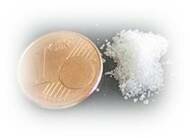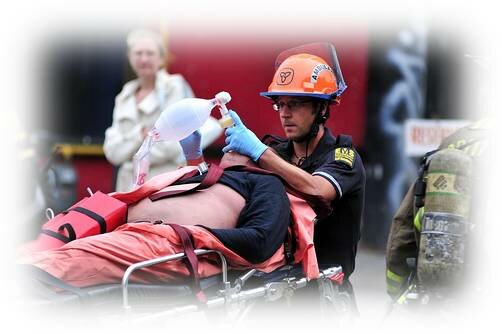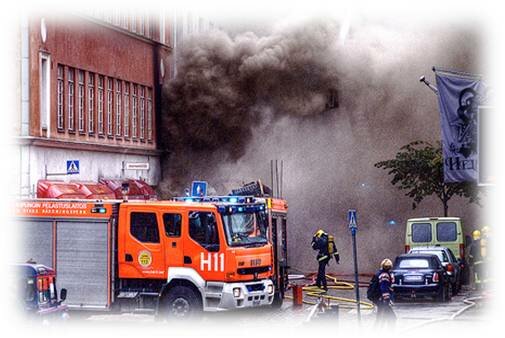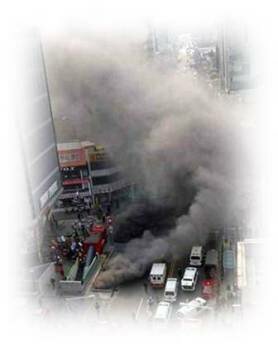Cyanide Poisoning Overview

Acute cyanide poisoning in combination with carbon monoxide poisoning frequently occur simultaneously in victims of fires, smoke inhalation, military operations and industrial accidents. In combination, both elements exhibit synergistic toxicity.
The term cyanide poisoning is also evokes associations of homicide or suicide victims poisoned with cyanide salts like potassium cyanide or of workers exposed to hydrogen cyanide gas.
Preventing death from cyanide poisoning primarily depends on the time between exposure and treatment. Therefore, the ability of the emergency responders to recognize and intervene rapidly in cyanide poisoning can mean the difference between life and death for smoke-inhalation victims.
What is Cyanide...

Cyanide is a toxic, deadly substance which has been used as a poison for thousands of years and often associated with murders and assassinations. Cyanide compounds are very toxic to humans, and inhalation exposure can be rapidly fatal. Potassium cyanide is among of the fastest of all poisons.
Cyanide compounds prevent the transfer of oxygen from the blood to body tissues as a result of selective inhibition of respiratory enzymes. The heart and central nervous system are particularly prone to rapid damage. Cyanides can enter the body by inhalation, by contact with the skin or eyes and if swallowed. Moderate and acute potassium cyanide poisoning cannot be treated at home. Immediate medical attention is always required.
Hundreds of thousands of tons of cyanide are manufactured annually for industry needs. Cyanide is used in many chemical syntheses, electroplating, plastics processing, gold and silver extraction, tanning, metallurgy, and as a fumigant. Cyanides are found in some foods, they are pyrolysis products of many substances.
In the fire sites the dangerous hydrogen cyanide fumes can be given off even after the fire is out but the material is still smoldering. Very mild cases might be shrugged off as a headache, but concentrations of a couple of hundred parts per million in air can kill within a few minutes. Antidotes are used and can be effective if administrated quickly, but the wrong diagnosis can also result in death.
It is important to recognize the difference between hydrogen cyanide and carbon monoxide poisoning. May be the most important reason for failing to consider a potential role of cyanide is the widely held perception that carbon monoxide is the most prevalent and dangerous of combustion products. The focus on carbon monoxide may cause healthcare professionals to overlook other potentially important toxicants.
Carbon Monoxide Poisoning
Carbon monoxide poisoning is associated with malfunctioning furnaces, automobile exhaust, hot water heaters, kerosene heaters, and stoves, as well as fires. Carbon monoxide occurs when the combustion of fuel is incomplete. Hydrogen cyanide is associated with the burning of plastics, especially if the fire is hot and in a confined space. Carbon monoxide concentrations of at least 1,500 ppm are associated with significant mortality. Ambient carbon monoxide concentrations can reach 1000 to 15,000 ppm during actual firefighting. Carbon monoxide poisoning is estimated to cause roughly 50% of all fire-related fatalities.

Photo courtesy of "mannequindisplay"
Symptoms Of Cyanide Poisoning
Many of the symptoms are the same for hydrogen cyanide and carbon monoxide: confusion, shortness of breath, headache, poor coordination, nausea, general weakness, excessive sweating, vomiting, drowsiness, seizures, sudden collapse, coma and death.
If the concentrations are high (>1,000 ppm), symptoms may occur 15 seconds after inhalation. Convulsions may occur in 15 to 30 seconds, and respiratory arrest in 2 or 3 minutes. Cardiac arrest follows within 6 to 8 minutes of exposure. If concentrations are lower, symptoms may not occur until after several minutes. Eventually respiratory and cardiac arrest occurs.
Differences between symptoms of hydrogen cyanide and carbon monoxide poisoning are subtle and difficult to characterize. Hydrogen cyanide inhalation will result in difficulty breathing, the person gasping for air even when he/she is brought out to fresh air whereas in the case of carbon monoxide poisoning she may simply feel sleepy but breathe normally.
The eye pupils may be normal or slightly dilated. A bright, red color of venous blood is a symptom of acute cyanide poisoning because of inability of tissue cells to utilize oxygen. Blood depleted in oxygen content will appear bluish or purple. Bright red skin and the absence of cyanosis (bluish or purple skin) have been described in patients with cyanide poisoning. Caution is indicated because cherry red skin may also be seen in some severe carbon monoxide poisoning cases.
Breathing the hot gas and smoke may cause thermal injury in the upper airway (mucosal damage, ethyhema [abnormal redness due to inflammation], ulceration, and oedema [tissue swelling due to fluid buildup]). There may be blistering and soot deposits in the nose and mouth. There may be adsorption of other toxins. Upper airway oedema usually becomes apparent within 24 hours of injury and usually resolves itself within 3 to 5 days. Some toxins in the smoke irritate the bronchial mucosa causing airway inflammation, resulting in coughing, breathlessness, wheezing, and excess bronchial secretions. Pulmonary oedema (fluid buildup in lungs) may occur in severe cases.
While the pervasiveness of cyanide substrates alone suggests that cyanide generation is a likely outcome of any modern fire, the degree to which cyanide contributes to smoke inhalation-associated morbidity and mortality has proven difficult to quantify. This difficulty may be attributed mainly to the frequent inability to obtain accurate measures of cyanide concentrations in the blood of fire victims. With a half-life of one hour, cyanide is short lived in the bloodstream.

Photo courtesy of Kyle Kesselring
Blood tests can conclusively distinguish between carbon monoxide and hydrogen cyanide poisoning, but tests take time. The blood tests include:
- Measurement of blood oxygen concentration (hospitals and some responders have a device that attaches to the end of a finger) gives useful information but may be misleading. Pulse oximetry alone cannot distinguish between COHb and oxyhemoglobin and is not a reliable measurement of oxyhemoglobin saturation.
- Measurement of carboxyhaemoglobin (COHb) concentration. Normal COHb levels for non-smokers breathing clean air are 0.3% to 0.7% (e.g.0.3% to 0.7% of hemoglobin is bound with carbon monoxide forming COGb). Smokers may be as high as 8%. COHb levels above 25% are considered toxic (symptoms: throbbing headache, slight confusion). COHb readings above 50% could result in unconsciousness. CoHb readings above 60% could result in death. Caution is indicated because patients receiving 100% oxygen treatment might have a normal COHb reading even though the carbon monoxide is not completely flushed out. Again, pulse oximetry is not a reliable estimate of oxyhemoglobin saturation.
- Measurement of carbon monoxide in the blood. If the person is breathing, some carbon monoxide may be detected in the gases exhaled.
- Measurement of carbon monoxide in the blood. If the person is breathing, some carbon monoxide may be detected in the gases exhaled.
- Measurement of blood cyanide concentrations. Nonsmokers: < 0.02 µg/ml; smokers typically 0.04 to 0.05 µg/ml; toxic > 0.2 µg/ml; tachycardia and flushing 0.5 to 1 µg/ml; coma 1 to 2.5 µg/ml; death >3 µg/ml.
- Measurement of plasma lactate concentration. A high plasma lactate (>10 mmol/L) in the absence of severe burns or hypotension is an indicator of cyanide toxicity.
- An increased mixed venous PO2 and a decreased difference in arteriovenous oxygen content suggests concurrent carbon monoxide and hydrogen cyanide poisoning.
Cyanide Poisoning And
Hyperbaric Oxygen Therapy (HBOT)
In victims of acute cyanide poisoning HBOT utilized as a supportive measure to the use of traditional cyanide antidote kit (the infusion of sodium nitrate) by reducing the toxicity of cyanide and augmenting the benefits of antidote treatment. Hyperbaric Oxygen mitigates histotoxic hypoxia caused by cyanide.
This is due to HBO2 hyper-oxygenating the plasma to the levels when sodium nitrite in the antidote kit onverts cyanhemoglobin to methemoglobin and lessens the hypoxic effect of methemoglobin itself. By reducing the hypoxic effects of methemoglobin HBO2 may have a direct effect in reducing the toxicity of cyanide and augmenting the benefits of antidote treatment.
Link to this page, insert the following code into your web page/blog...














